The EVGA X570 Dark Motherboard Review: A Dark Beast For Ryzen
by Gavin Bonshor on October 8, 2021 8:00 AM ESTVisual Inspection
The EVGA X570 Dark follows a very similar design to its Intel-based Z590 Dark model. This includes a primarily black aesthetic, with RGB LEDs integrated into the rear panel cover, making the X570 Dark logo pop nicely. The EVGA X570 Dark has plenty of weird design traits compared to a conventional desktop model, with perhaps the most notable design characteristic is the transposed CPU socket. This is designed for extreme overclockers allowing for much better LN2 pot mounting compatibility without providing hindrance or access to the top-mounted PCIe 4.0 x16 slot.
Looking at PCIe support, the EVGA X570 Dark has two full-length PCIe 4.0 slots with metal reinforcement that can operate at x16 and x8/x8, with one half-length x4 slot. Sandwiched in-between the PCIe 4.0 slots are two PCIe 4.0 x4 M.2 slots, which are both covered by a large Dark themed M.2 heatsink. To the right of this is a passively cooled chipset heatsink, which many newer X570S chipset boards now feature. Other storage options include eight SATA ports with six of these supporting RAID 0, 1, and 10 arrays, and the other two coming via an ASMedia ASM1061 SATA controller.
Moving the two DDR4 memory slots across the top from the top right-hand corner allows for more access to the CPU socket area and is also designed to make insulation for sub-zero cooling easier. The EVGA X570 Dark supports DDR4-4800 out of the box when overclocked, with a maximum combined capacity of up to 64 GB across both slots.
As expected on a model focused on overclocking, the EVGA X570 Dark has plenty of hardware-level features for enthusiasts. This includes a Probelt header for real-time voltage monitoring, including CPU VCore, VDIMM, VDDP, SoC, and PLL. Also present is a clear CMOS button, a Safeboot button, dual two-digit LED debuggers, a dedicated USB port for BIOS flashing, a power button, and a reset button.
Another space-saving element while on sub-zero, although the complete opposite for daily use, is the right-angled power connectors and front panel headers. This includes a 24-pin 12 V ATX motherboard power input, two 8pin 12 V ATX CPU power inputs, as well as all of the board's front panel USB and 4-pin fan headers. Overclockers like to keep these out of the way when actively monitoring a system, although daily users will need to find chassis that fit the E-ATX as well as the cables coming from the board. Touching more on cooling, EVGA includes eight 4-pin headers with two dedicated to CPU fans, two for water pumps, and four for chassis fans.
Focusing on the power delivery of the EVGA X570 Dark, it has a very premium 17-phase design with a Renesas RAA 229004 PWM controller operating in a 14+2+1 configuration. Looking at the CPU section, the X570 Dark uses fourteen Intersil ISL99390 90A power stages with a maximum current of 1260 amps to the CPU. Despite including no integrated graphics support, the small SoC section includes two Intersil ISL99390 90 A power stages operating with one Intersil ISL6617A doubler. The CPU section also uses seven Intersil ISL6617A doublers, which means the core and SoC part of the power delivery is running in a 7+1 configuration. Providing power to the power delivery is a pair of right-angled 8-pin 12 V ATX CPU power inputs, which can be found on the right-hand side of the board.
Keeping the power delivery cool is a vast and elaborate actively cooled heatsink. The main two sections feature large aluminum fin arrays, which sit quite high and forms an L-shape, with a single S-shaped heat pipe connecting it to the large chipset heatsink. EVGA includes two small cooling fans, which, when ramped up, do make a bit of a whine on an open test-bed. The large dual M.2 heatsink comes in one solid piece and includes a sizeable Dark series logo with a good number of fins to help pick up passive airflow when installed into a system.
For onboard audio, EVGA is using the Realtek ALC1220 HD audio codec at the heart of its audio solution. An EVGA NU audio SV3H615 headphone amplifier assists the audio, which adds an extra element of quality. Unlike other vendors in terms of audio capacitors, EVGA equips the board with four large and yellow Bennic Bi-Polar high impedance audio capacitors.
On the rear panel of the X570, the Dark has a modest selection of input and output. In terms of USB connectivity, the rear panel includes one USB 3.2 G2 Type-C, four USB 3.2 G2 Type-A, and two USB 3.2 G1 Type-A ports. The preinstalled I/O shield has honeycomb ventilation to allow the two power delivery cooling fans to vent out hot hair from the rear. For networking, the X570 Dark includes two Intel I225-V 2.5 GbE controllers and an Intel AX200 Wi-Fi 6 wireless interface that supports BT 5.2 devices.
EVGA has decided to opt for the Realtek ALC1220 HD audio codec assisted by an EVGA NU SV3H615 headphone amplifier and powers the five 3.5 mm audio jacks and S/PDIF optical output. Finishing off the rear panel is a PS/2 keyboard and mouse combo port and a small red clear CMOS button.
What's in The Box
Some of the most notable accessories supplied with the EVGA X570 Dark include a small USB stick with all of the board's drivers, four black SATA cables, three M.2 thermal pads, two Probelt cables for voltage monitoring, and a Wi-Fi 6 antenna.
Also included within the accessories bundle is an EVGA X570 Dark branded bench stand, which not only allows users to combine this with the ten long standoffs to be used as a test bench of sorts, but it also provides a hardware map of the board printed onto it.
- Quick installation guide
- Bench table stand
- 10 x standoffs and screws
- Intel WI-Fi 6 antenna
- Driver installation USB drive
- 4 x SATA cables
- 3 x M.2 thermal pads
- 2 x Probelt OC cables
- EVGA sticker


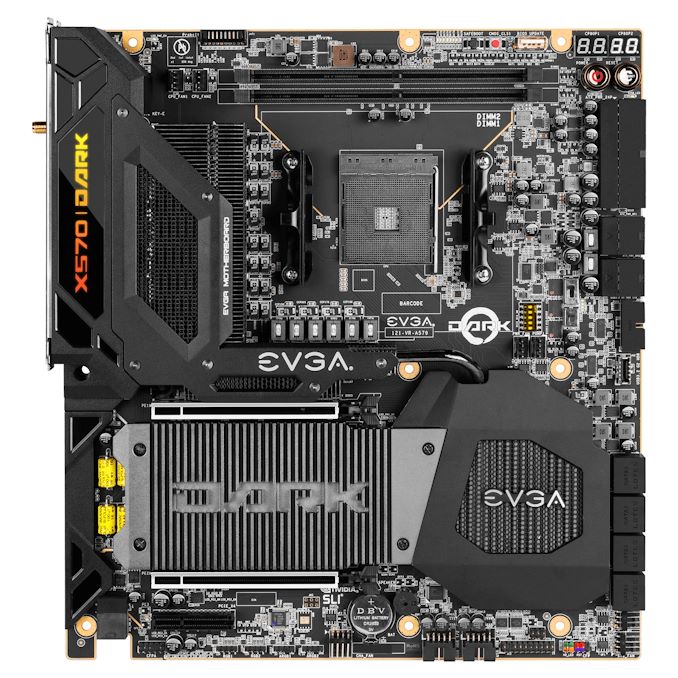

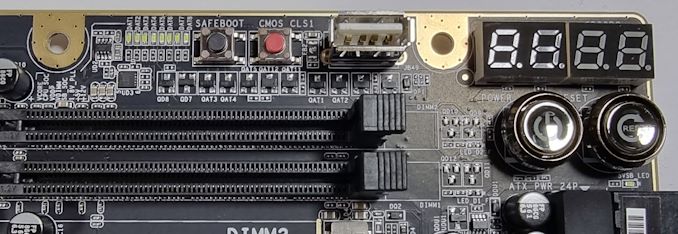

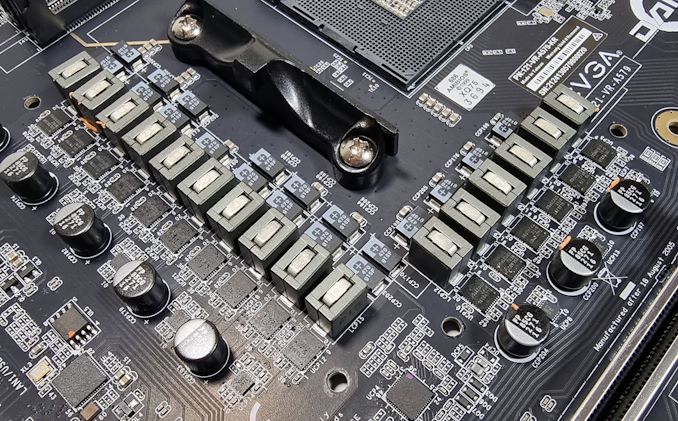
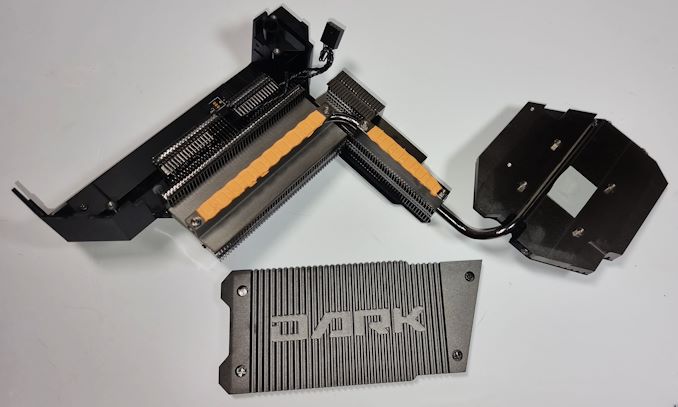
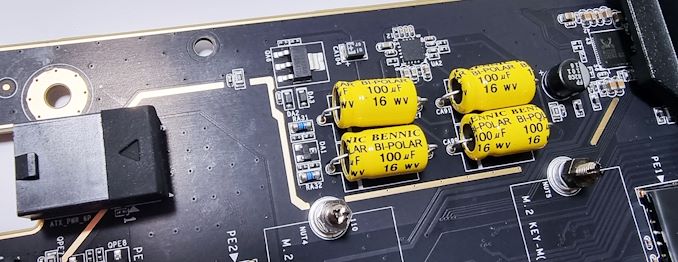
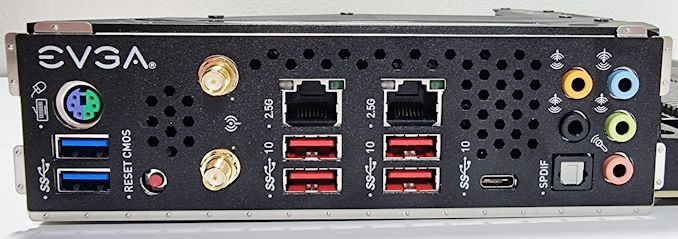
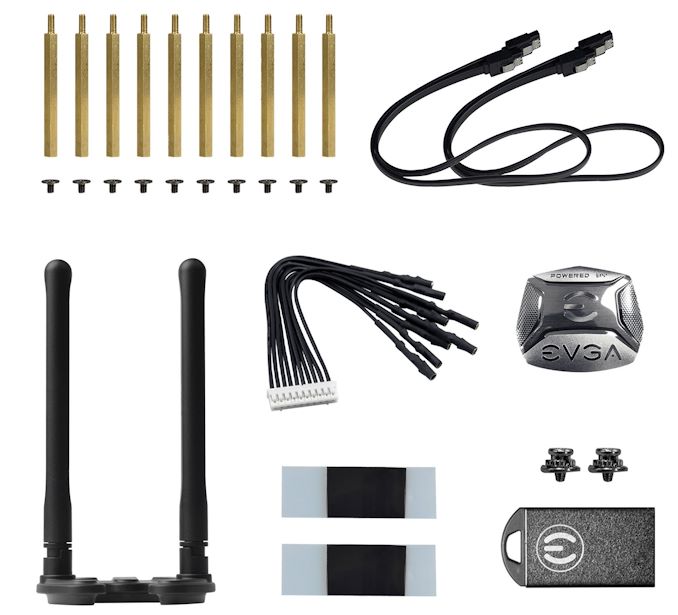









36 Comments
View All Comments
Eliadbu - Saturday, October 9, 2021 - link
Or RGB, but it has 2nd NIC and m.2 key E (incase you want to add wifi card).jtd871 - Friday, October 8, 2021 - link
AFAIK, RAM overclocking is more stable when you are using only 2 sticks, and this is a 'halo' board designed primarily for competitive overclocking.You wouldn't use a top-fuel dragster as your daily commuter car or to show up to a formal red-carpet event. In the same way, this board is not intended for 'normal' computing or gaming.
Threska - Friday, October 8, 2021 - link
Now I'm just waiting for the workstation/server version.WaltC - Friday, October 8, 2021 - link
I couldn't believe that I read this sentence in the review of this mboard:"While these comments make sense, ultimately very few users apply memory profiles (either XMP or other) as they require interaction with the BIOS."
There will be zero (0) customers of this motherboard who will decline to use the bios...;) Every single one of them will be quite conversant with the bios and eager to use it.
Seem to be a lot of this kind of general assumptions here that really have no relevance for the people who will be buying this product.
WaltC - Friday, October 8, 2021 - link
If I missed the place where you discussed a dual bios on this motherboard, or its lack of one, I beg pardon. But there are a lot of interesting DIP switches visible on this motherboard and a brief explanation would have been nice. Also, why would you test a 65W CPU with this board? Seems like a 5900X or 5950X would have been far more interesting, not to mention in keeping with the type of CPU a customer of the $690, OC'ing board is much more likely to purchase.I did agree with your conclusion, though, about boards costing half as much having very similar features and options--for instance, my two-year old x570 Aorus Master ($350) includes both the RT 1220-VB HD & a headphone AMP for onboard sound, but the x570 Master also includes a hardware DAC, the SABRE 9118, while the EVGA board lacks a hardware DAC. The Master includes 4 DIMM slots, and a manually switched dual-bios setup--which in my estimation is just about a requirement for an overclocking board--which the Master is, even though it doesn't have the VRM chops of this EVGA board. But my Master was shipped on the same day that Zen2 CPUs shipped from AMD, so I think the EVGA board is targeting upper-end Zen3 CPUs for OC'ing.
But as I mentioned earlier, trust me when I say that nobody will be buying a $690 OC'ing board who is afraid to go into his bios...;) Glad to see EVGA supporting AMD again, and like you, it will be nice to see a range of AMD4/5 EVGA board products at some point.
Oxford Guy - Saturday, October 9, 2021 - link
"While these comments make sense, ultimately very few users apply memory profiles (either XMP or other) as they require interaction with the BIOS."Stuff like this is a gift (of hilarity) that keeps on giving.
Silver5urfer - Friday, October 8, 2021 - link
There are few things, first this board doesn't use ASM SATA controller, I think you should correct that. All 8 SATA ports are from chipset only. The extra PCB for LN2 also shows the same, Manual also states the same.Now moving on to the board vs Z590 DARK. They removed one NVMe M.2 slot on this, Downgraded the phases and smaller Aluminum heatsink instead of massive Copper block on Interl board, then we have the rear DP and HDMI removed.
Next, the bigger things. First is the USB ports, the board has rear I/O from Chipset only. None of them are from CPU. Usually all X570(S) boards have ton of CPU USB ports, EVGA chose not to for this board. I can guess the only reason being AMD Ryzen 5000 CPUs have issues with the USB ports dropping and all sort of bugs, still not ironed out. So they avoided those, but the front I/O panel ports will be from CPU only, on top they dropped the ASMedia controller for USB C unlike the Z590 DARK. They also dropped the U.2 port.
Next is why they did they go with the Dual DIMM slots, Ryzen doesn't do well with Dual Rank B-Die kits unlike Intel which likes them. Now we have to be too cautious on that part due to the Zen 3 IMC. Now the price, it's highway robbery period. The board is exactly priced at X570 Aorus Xtreme at $700 which not only packs everything this has but even more. Plus it also has the 10G LAN, on top of the HiFi DAC which is not that buggy trash ALC4080 class, instead ALC1200 like this. Crosshair VIII Extreme is $100 more but it has more features, however it has that dreaded garbage ALC4082 and all that ASUS bloatware for the proper functioning of the DAC/AMP hardware. These guys should have included a 10G LAN port at-least, they really are saving a ton of cash on this board, simply a Z590 DARK based PCB design with extra PCIe 4.0 M.2 drive and much more reduced components and choices vs Intel board.
Coming to review, surprised on the DPC latency of this board. Now I'm just waiting on how this board does, esp related to the AMD Ryzen stability with Memory and OC AND USB. Also it's a shame that there's no Ryzen 5000 used for review and no Memory tuning as well. Everything this board got going is all about OC and unlocking potential...
leexgx - Friday, October 8, 2021 - link
If you use 2x dual rank sticks (anything above 16gb per stick) is exactly the same as using 4x8gb single rank sticks (because it's in dual rank due to 2 single ranks per channel)The point of this motherboard is for lm2 overclocking is why there is 2 slots
Slash3 - Saturday, October 9, 2021 - link
EVGA's specifications page does still list two ASMedia SATA ports, and they were incorporated on the Z590 and other, previous Dark boards for XP compatibility. It's possible that they were on internal or pre-release samples but then removed for the retail version.PsychoOC - Friday, October 8, 2021 - link
Whats ironic is the world record holder for most ln2 benchmarks on 3700x is on b450 tomahawk;)